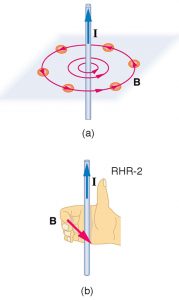33 Sources of Magnetic Fields
Magnetic Fields Produced by Currents: Ampere’s Law
Derived from Ampere’s Law by

Instructor’s Note
- that moving charges (i.e., currents) are ultimately the source of all magnetic fields
- that magnetic field lines travel in closed loops
- how to calculate the magnitude of the magnetic field some distance from a straight wire
How much current is needed to produce a significant magnetic field, perhaps as strong as the Earth’s field? Surveyors will tell you that overhead electric power lines create magnetic fields that interfere with their compass readings. Indeed, when Oersted discovered in 1820 that a current in a wire affected a compass needle, he was not dealing with extremely large currents. How does the shape of wires carrying current affect the shape of the magnetic field created? We noted earlier that a current loop created a magnetic field similar to that of a bar magnet, but what about a straight wire or a toroid (doughnut)? How is the direction of a current-created field related to the direction of the current? Answers to these questions are explored in this section, together with a brief discussion of the law governing the fields created by currents.
Magnetic Field Created by a Long Straight Current-Carrying Wire: Right Hand Rule 2
Magnetic fields have both direction and magnitude. As noted before, one way to explore the direction of a magnetic field is with compasses, as shown for a long straight current-carrying wire in Figure 1. Hall probes can determine the magnitude of the field. The field around a long straight wire is found to be in circular loops. The right hand rule 2 (RHR-2) emerges from this exploration and is valid for any current segment—point the thumb in the direction of the current, and the fingers curl in the direction of the magnetic field loops created by it.

The magnetic field strength (i.e., magnitude) produced by a long straight current-carrying wire is found by experiment to be
![]()

Instructor’s Note
I would like you to be able to use the equation above to get a numerical value.
where ![]() is the current,
is the current, ![]() is the shortest distance to the wire, and the constant
is the shortest distance to the wire, and the constant ![]() is the permeability of free space. (
is the permeability of free space. (![]() one of the basic constants in nature. We will see later that
one of the basic constants in nature. We will see later that ![]() is related to the speed of light.) Because the wire is very long, the magnitude of the field depends only on distance from the wire
is related to the speed of light.) Because the wire is very long, the magnitude of the field depends only on distance from the wire ![]() , not on position along the wire.
, not on position along the wire.
Calculating Current that Produces a Magnetic Field
Find the current in a long straight wire that would produce a magnetic field twice the strength of the Earth’s at a distance of 5.0 cm from the wire.
Strategy
The Earth’s field is about ![]() and so here
and so here ![]() due to the wire is taken to be
due to the wire is taken to be ![]() . The equation
. The equation ![]() can be used to find
can be used to find ![]() , since all other quantities are known.
, since all other quantities are known.
Solution
Solving for ![]() and entering known values gives
and entering known values gives
![]()
![]()
Discussion
So a moderately large current produces a significant magnetic field at a distance of 5.0 cm from a long straight wire. Note that the answer is stated to only two digits, since the Earth’s field is specified to only two digits in this example.
Ampere’s Law and Others
The magnetic field of a long straight wire has more implications than you might at first suspect. Each segment of current produces a magnetic field like that of a long straight wire, and the total field of any shape current is the vector sum of the fields due to each segment. The formal statement of the direction and magnitude of the field due to each segment is called the Biot-Savart law. Integral calculus is needed to sum the field for an arbitrary shape current. This results in a more complete law, called Ampere’s law, which relates magnetic field and current in a general way. Ampere’s law, in turn, is a part of Maxwell’s equations, which give a complete theory of all electromagnetic phenomena. Considerations of how Maxwell’s equations appear to different observers led to the modern theory of relativity, and the realization that electric and magnetic fields are different manifestations of the same thing. Most of this is beyond the scope of this text in both mathematical level, requiring calculus, and in the amount of space that can be devoted to it. But for the interested student, and particularly for those who continue in physics, engineering, or similar pursuits, delving into these matters further will reveal descriptions of nature that are elegant as well as profound. In this text, we shall keep the general features in mind, such as RHR-2 and the rules for magnetic field lines listed in Magnetic Fields and Magnetic Field Lines, while concentrating on the fields created in certain important situations.
Making Connections: Relativity
Hearing all we do about Einstein, we sometimes get the impression that he invented relativity out of nothing. On the contrary, one of Einstein’s motivations was to solve difficulties in knowing how different observers see magnetic and electric fields.
Section Summary
- The strength of the magnetic field created by current in a long straight wire is given by
![]() ,
,
where ![]() is the current,
is the current, ![]() is the shortest distance to the wire, and the constant
is the shortest distance to the wire, and the constant ![]() is the permeability of free space.
is the permeability of free space.
- The direction of the magnetic field created by a long straight wire is given by right hand rule 2 (RHR-2): Point the thumb of the right hand in the direction of current, and the fingers curl in the direction of the magnetic field loops created by it.
- The magnetic field created by current following any path is the sum (or integral) of the fields due to segments along the path (magnitude and direction as for a straight wire), resulting in a general relationship between current and field known as Ampere’s law.

